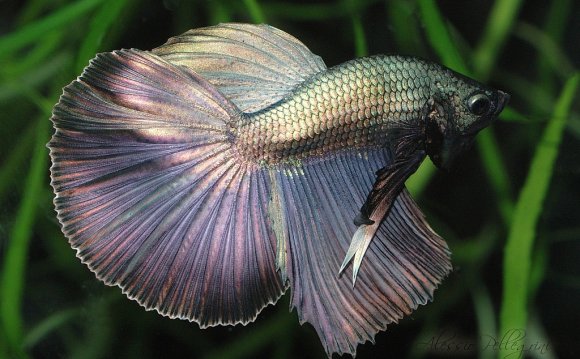|
|
Betta Behavior and Husbandry: Linking Betta splendens Aggression with Community Tank Preservation
|
|
By Lonnie Lindberg
|
Bright colors, elegant finnage, and a feisty attitude to boot….these are the traits that have attracted young and old alike to the remarkable world of the Betta fish.
Known as the Siamese fighting fish, the domesticated betta (Betta splendens) began in the rice paddies of Thailand. There are over a dozen wild known betta fish species living in the world today, with most being found in southern Malaysia and nearby Indonesia. In these tropical waters, the wild betta fish is a far cry from the gorgeous domestic strain. They lack the vibrant colors and the gorgeous trademark fins. Domesticated male betta fish come in a variety of colors and fin types. There are twelve fin styles in all, but the most common types are the veil tail, crown tail, delta, super delta, and half moon. Females tend to be not as popular as the males due to the lack of the graceful fins. However, they too come in a collection of eye-catching colors that can rival any male.
What is common between the wild male betta and the male Betta splendens is that both are known to display extremely aggressive behavior between fellow males and unwilling females. I have also witnessed extreme aggression from female betta fish, as well. Therefore it is important to know and understand the factors that can trigger the fighting instincts in the Betta splendens, especially within the males of the species.
Researching Male Betta splendens Aggression
In college I conducted two experiments on male betta fish behavior. All test subjects were kept separate and no animals were harmed during the course of the experiment. All of the bettas were kept in 10 gallon (37.5 litre) tanks during both tests. As is necessary for bettas, the water temperature was kept between 79-80 degrees Fahrenheit (26-27 degrees Celsius). Just as with humans, they require a healthy and variable diet full of fiber. Since these are carnivorous fish, I provided a diet of brine shrimp and freeze dried bloodworms. Before feeding, I recommend gut loading the brine shrimp. Crush up some flake fish food and wait about half an hour for the shrimp to ingest the flakes. Daphnia, blood worms, and brine shrimp are an inexpensive and necessary component of your betta’s life. To avoid overfeeding, I recommend feeding betta fish once every three days.
Experiment 1
For my first experiment, I hypothesized that male Betta splendens only attack males of the same species. To avoid distraction, all the tanks were kept bare of any substrate or furnishings. I was quite surprised and somewhat thrilled of the final product. I’ll spare you the statistical results and simply say that my hypothesis was thoroughly mistaken. Not only were there attempted attacks on fellow males and females, but also on a male fancy guppy and a fish that looks nothing like a Betta…a goldfish. Yes, you read correctly, a goldfish. I honestly wasn’t that surprised about the attacks on the guppy as male fancy guppies tend to resemble the physical characteristics of bettas. Yet a goldfish that looks nothing like a betta and is larger in stature still provoked aggression.
Experiment 2
My second experiment was presented at the 28th Annual Western Pennsylvania Research Symposium at Carlow College, Pittsburgh USA. With this one I wanted to determine if territoriality was linked to a form of cover in the male Betta splendens. In this test I had six male Bettas as my subjects and provided aquatic plants as the form of shelter. I tested when two males had cover, when neither had cover, and when only one had cover. All fish were tested against each other in those scenarios for a total of sixty trials. I thought that having a form of cover would indeed provoke more aggression. No, once again I was proven incorrect. One would think that the males would fight over luscious plants perfect for egg laying. However, males were more aggressive without any cover at all.
What Does This Mean For Betta Community Tanks?
My research revealed that there can be multiple contributing factors in betta fish aggression. Therefore it is important to know and understand the dynamics that can trigger the fighting instincts in the Betta splendens, especially within the males of the species. One such factor is age. In my report I noted that my older males were more interested in foraging around on the gravel floor than in fighting. The average pet store betta is already quite mature upon arrival. Unless you’re buying from a betta breeder who knows the lineage and age of all of his stock, there’s no way of knowing the “personality”. The variety of betta also seems to play a role. For example, the Crown Tails seemed more willing to engage in combat and appeared to have a more energetic display than the Veil Tails. Naturally, genetics can also contribute to behavior; however I did not know the lineages of my test subjects.
|










